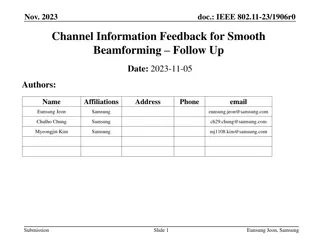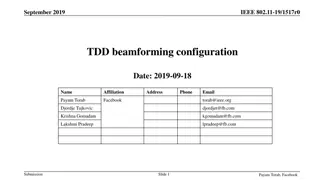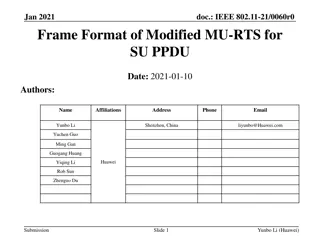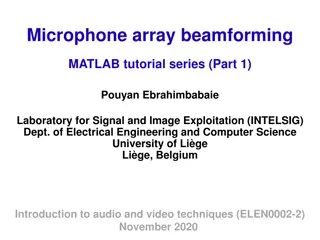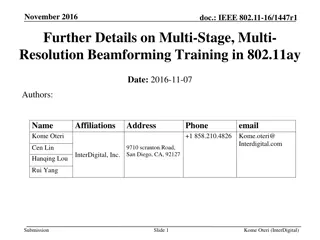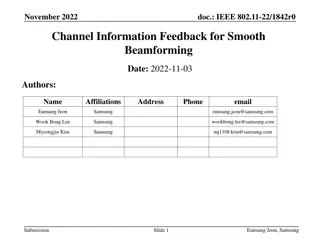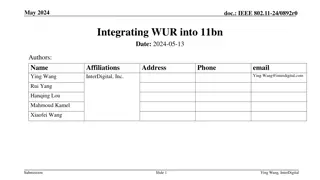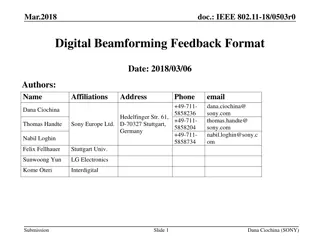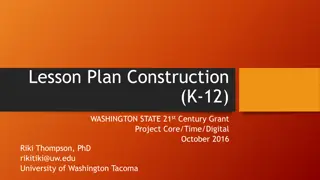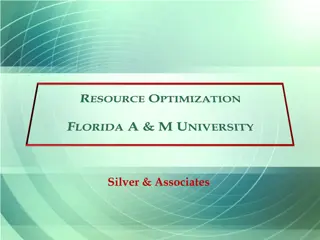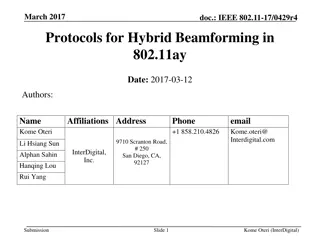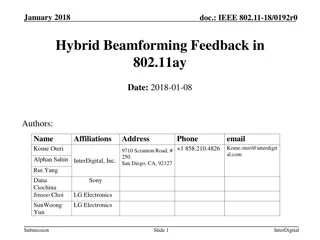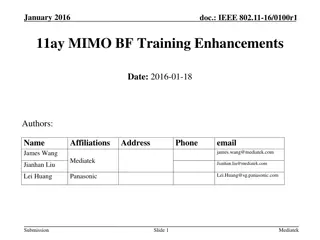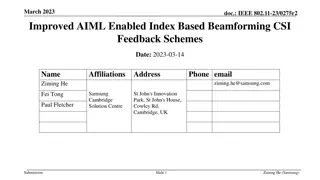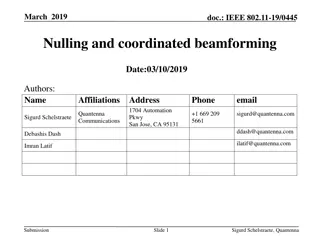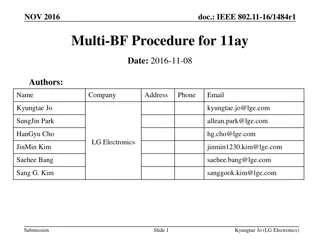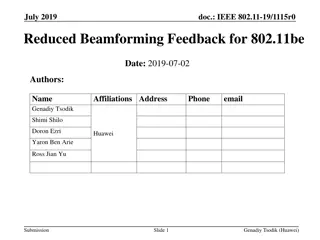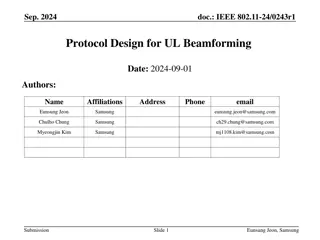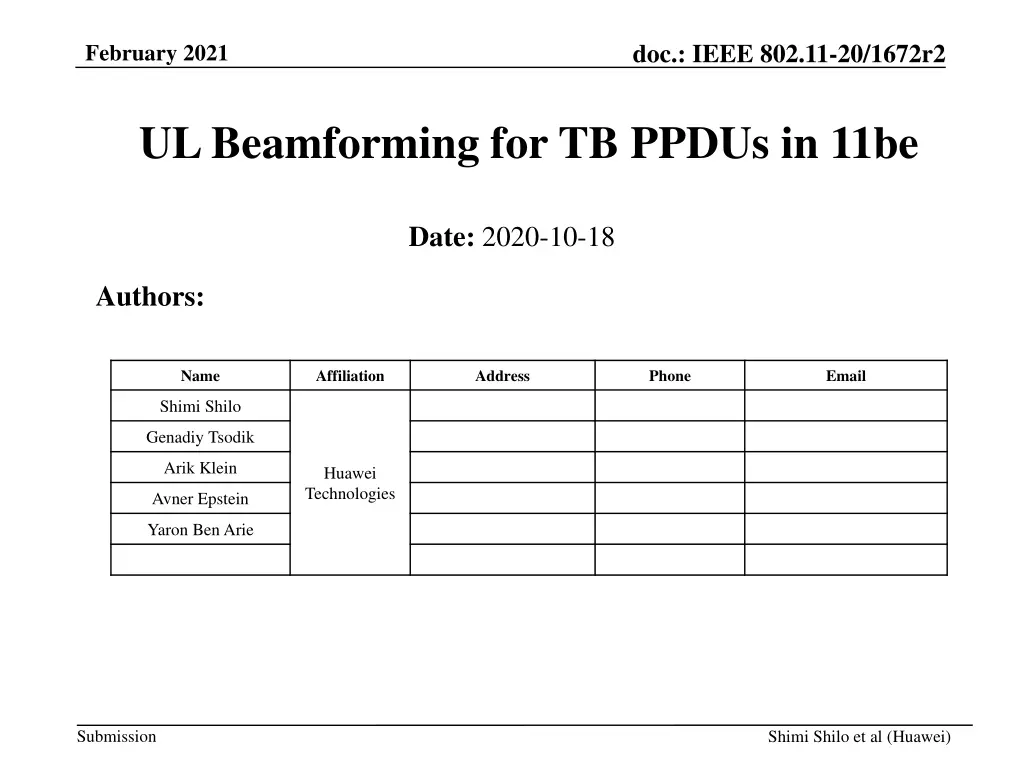
UL Beamforming for TB PPDUs in IEEE 802.11be Standard
Learn about UL beamforming for TB PPDUs in the IEEE 802.11be standard, including background information, limitations in 11ax, and the protocol for UL beamforming in an SU operation.
Download Presentation

Please find below an Image/Link to download the presentation.
The content on the website is provided AS IS for your information and personal use only. It may not be sold, licensed, or shared on other websites without obtaining consent from the author. If you encounter any issues during the download, it is possible that the publisher has removed the file from their server.
You are allowed to download the files provided on this website for personal or commercial use, subject to the condition that they are used lawfully. All files are the property of their respective owners.
The content on the website is provided AS IS for your information and personal use only. It may not be sold, licensed, or shared on other websites without obtaining consent from the author.
E N D
Presentation Transcript
doc.: IEEE 802.11-20/1672r2 February 2021 UL Beamforming for TB PPDUs in 11be Date: 2020-10-18 Authors: Name Affiliation Address Phone Email Shimi Shilo Genadiy Tsodik Arik Klein Huawei Technologies Avner Epstein Yaron Ben Arie Submission Shimi Shilo et al (Huawei)
doc.: IEEE 802.11-20/1672r2 February 2021 Background Beamforming has been supported since 802.11n It is widely used as a means to improve the performance and/or throughput Beamforming is supported for both DL and UL for a single STA in SU operation There are devices in the market today that support BF in the UL In 11ax, beamforming is not supported for a Trigger-Based PPDU (i.e. UL MU operation) In this contribution we focus on beamforming in the UL and in particular on supporting it for a Trigger-Based PPDU In 1672r1 we add: Simulation results for SU PPDU using a geometric channel model (e.g. using vertical/horizontal polarization) Beneficial use-cases for using UL MU Beamforming In 1672r2 we add information regarding the UL BF sequence Submission Shimi Shilo et al (Huawei) Slide 2
doc.: IEEE 802.11-20/1672r2 February 2021 UL BF Limitations for a Trigger-Based PPDU in 11ax In 11ax UL, beamforming is limited to an HE SU/ER PPDU transmitted by a single STA It is not possible to support beamforming in an HE TB PPDU for several reasons: The AP cannot indicate to the STAs (in the preceding Trigger Frame) to apply beamforming in an UL TB PPDU There is no indication that beamforming is applied in HE-SIG-A of an HE TB PPDU If the sounding procedure is not triggered by the AP (beamformee), how and when do the STAs perform sounding? How do they ensure it is done before the UL BFed data transmission is invoked by the HE AP? Furthermore, if each STA needs to perform sounding independently, efficiency is compromised significantly We need to solve all of these issues for BF to be supported (efficiently) in 11be Submission Shimi Shilo et al (Huawei) Slide 3
doc.: IEEE 802.11-20/1672r2 February 2021 UL BF in an SU operation Let us start by looking at the existing protocol for UL BF in an SU operation The baseline is an UL HE SU PPDU without BF UL BF is supported by the STA (beamformer) invoking the procedure, first by transmitting an NDP-A followed by an HE Sounding NDP, which is responded by the AP (beamformee) with a BFR BA AP No BF UL Data STA1 BFR BA AP With BF NDPA NDP UL Data (Bfed) STA1 Submission Shimi Shilo et al (Huawei) Slide 4
doc.: IEEE 802.11-20/1672r2 February 2021 UL BF in an SU operation cont. What gain can we get from the application of BF in the UL, considering that STAs typically are equipped with few antennas? We start with a link-level simulation, which we then use to compute the corresponding goodput, assuming the following: STA with 2 Tx antennas, AP with 8 Rx antennas 20MHz BW (242-tone RU) Single spatial stream Durations: 16usec symbol duration NDP-A: 28usec Sounding NDP: 60usec Block ACK: 50usec BFR: 92usec (assuming MCS 3, Ng=4, 2 angles per tone) Data PPDU: 60usec (preamble)+1000B data (duration depends on MCS) Submission Shimi Shilo et al (Huawei) Slide 5
doc.: IEEE 802.11-20/1672r2 February 2021 UL BF in an SU operation cont. The following figure shows the PER results for this scenario As expected, the gap is slightly larger than 3dB (for most cases) But considering the overhead required to support BF, what is the real gain? Submission Shimi Shilo et al (Huawei) Slide 6
doc.: IEEE 802.11-20/1672r2 February 2021 UL BF in an SU operation cont. We compute the goodput for both schemes, for various payload sizes (aggregation) - alternatively, this could be replaced by multiple PPDUs transmitted within each sounding period At each SNR, we find the MCS which maximizes the throughput When the STAs transmit an aggregation of ~8 MPDUs, BF yields higher throughput for the majority of the SNR range For larger MPDU aggregation, BF always improves throughput Submission Shimi Shilo et al (Huawei) Slide 7
doc.: IEEE 802.11-20/1672r2 February 2021 UL BF in an SU operation cont. Simulations were repeated using a geometric channel model, where the STA s transmitting antennas are spaced lambda (6cm at fc=5GHz) apart using the same polarization; the AP s antennas are placed on a ULA with lambda/2 separation (using same polarization) Link level simulations were carried out for MCS 2 to 7 With sufficient data transmitted within a sounding period there is a ~2-4dB gain Submission Shimi Shilo et al (Huawei) Slide 8
doc.: IEEE 802.11-20/1672r2 February 2021 UL BF in an SU operation cont. Simulations were repeated using a geometric channel model, where the STA s transmitting antennas are spaced lambda (6cm at fc=5GHz) apart using a different polarization (horizontal and vertical); the AP s antennas are placed on a ULA with lambda/2 separation (using the same polarization) Link level simulations were ran for MCS 2 to 7 With sufficient data transmitted within a sounding period there is a ~2-3dB gain Submission Shimi Shilo et al (Huawei) Slide 9
doc.: IEEE 802.11-20/1672r2 February 2021 UL BF in MU operation (TB PPDU) Having verified that UL BF is applicable in certain scenarios, we now turn to Trigger-Based PPDUs If there is no beamforming, the AP triggers the STA(s) to transmit UL data Basic TF AP BA UL Data STA1 No BF UL Data STA2 UL Data STA3 The AP cannot instruct the triggered STAs to apply BF, and the triggered STAs cannot indicate to the AP that they precoded their transmission Is there a way to support TB PPDUs with beamforming, and if so, what is the respective gain? Submission Shimi Shilo et al (Huawei) Slide 10
doc.: IEEE 802.11-20/1672r2 February 2021 UL BF in MU operation (TB PPDU) cont. Since there is no support for UL BF in a HE TB PPDU, we assume the following high-level protocol Triggering NDP Triggering Data+BFR BA AP NDP UL Data (Bfed) STA1 With BF NDP UL Data (Bfed) STA2 NDP UL Data (Bfed) STA3 Unlike the existing protocol for SU operation (with BF), the AP (beamformee) triggers the sounding procedure for an efficient sounding procedure After receiving the Sounding NDPs (in HE TB PPDUs), the AP sends the Per-User precoding feedback values with the TF that initiates the UL MU Data transmission. Submission Shimi Shilo et al (Huawei) Slide 11
doc.: IEEE 802.11-20/1672r2 February 2021 UL BF in MU operation (TB PPDU) cont. The solicited STAs use the precoding values to respond with Beamformed Uplink data HE TB PPDUs Triggering NDP Triggering Data+BFR BA AP NDP UL Data (Bfed) STA1 With BF NDP UL Data (Bfed) STA2 NDP UL Data (Bfed) STA3 The details of the protocol should be discussed at a later stage; here we make these assumptions in order to evaluate the achievable gain Submission Shimi Shilo et al (Huawei) Slide 12
doc.: IEEE 802.11-20/1672r2 February 2021 UL BF in MU operation (TB PPDU) cont. What gain can we get from the application of BF in an UL TB PPDU? Just like the SU PPDU case, we start with a link-level simulation, which we then use to compute the corresponding goodput, assuming the following: 2 STA with 2 Tx antennas each, AP with 8 Rx antennas 20MHz BW (242-tone RU) Single spatial stream transmitted by each STA Durations: 16usec symbol duration Triggering NDP: 28usec Sounding NDP: 76usec (assuming 2x2=4 LTFs transmitted by each STA) Block ACK: 50usec BFR: 124usec (assuming MCS 3, Ng=4, 2 angles per tone) Data PPDU: 60usec (preamble)+1000B data (duration depends on MCS) Submission Shimi Shilo et al (Huawei) Slide 13
doc.: IEEE 802.11-20/1672r2 February 2021 UL BF in MU operation (TB PPDU) cont. We compute the goodput for various payload sizes (aggregation) and assuming the durations listed earlier At each SNR, we find the MCS which maximizes the throughput When the STAs transmit an aggregation of ~10 MPDUs, BF yields higher throughput for a majority of the SNR range For larger aggregation, BF is superior across the entire SNR range Submission Shimi Shilo et al (Huawei) Slide 14
doc.: IEEE 802.11-20/1672r2 February 2021 UL BF in MU operation (TB PPDU) cont. We also checked for a different scenario (UL MU-MIMO with 4 STAs): 4 STA with 2 Tx antennas each, AP with 8 Rx antennas 20MHz BW (242-tone RU) Single spatial stream transmitted by each STA Durations: 16usec symbol duration Triggering NDP: 28usec Sounding NDP: 108usec (assuming 4x2=8 LTFs transmitted by each STA) Block ACK: 50usec BFR: 188usec (assuming MCS 3, Ng=4, 2 angles per tone) Data PPDU: 60usec (preamble)+1000B data (duration depends on MCS) Submission Shimi Shilo et al (Huawei) Slide 15
doc.: IEEE 802.11-20/1672r2 February 2021 UL BF in MU operation (TB PPDU) cont. We compute the goodput for both schemes, for various payload sizes (aggregation) and assuming the durations listed earlier Similar to the previous case, at each SNR, we find the MCS which maximizes the throughput Results are similar to the 2STAs case as the number of aggregated MPDUs increases, so does the gain incurred by BF Submission Shimi Shilo et al (Huawei) Slide 16
doc.: IEEE 802.11-20/1672r2 February 2021 Where is it Beneficial to use MU UL BF? The following are examples for scenarios where MU UL BF should be considered: Large PSDU / Large number of aggregated MPDUs (high payload) per STA Using BSR as reported by the STAs, the AP is aware of expected amount of data to be sent by each STA Allocating ? spatial streams with ? < ? number of Tx antennas per user AP chooses number of allocated streams per STA based on various conditions/inputs Allocating maximum number of streams is not a typical case It is possible to yield BF gain with ? = ?using enhanced precoders When triggering multiple STAs, not all STAs have to be triggered to apply BF (OFDMA and/or MU-MIMO) E.g. when only a subset of STAs is capable Submission Shimi Shilo et al (Huawei) Slide 17
doc.: IEEE 802.11-20/1672r2 February 2021 PHY related Complexity Aspects The AP (beamformee) can feedback phase-aligned, continuous precoders to the STAs Therefore, the STAs need only perform interpolation in frequency very low complexity This also ensures the AP can apply smoothing while demodulating the precoded data Alternative precoding methods (e.g. wider bandwidth precoders) can also be considered This means further reduction of complexity at STA side, requiring no interpolation and ensuring continuity in frequency Significant complexity reduction respective to precoder computation Can also reduce the overhead Submission Shimi Shilo et al (Huawei) Slide 18
doc.: IEEE 802.11-20/1672r2 February 2021 Summary We discussed Uplink BF in 802.11, in particular the lack of support for TB PPDUs in 11ax We ve shown via simulations that supporting BF in the UL, even when considering STAs with 2Tx antennas, is legitimate When we take the overhead associated with the protocol (Sounding NDP etc.) into consideration, there are scenarios where UL BF improves the performance There are devices today supporting UL BF, but this cannot be used in a TB PPDU We propose several use-cases where MU UL BF is beneficial We propose to support BF for TB PPDUs in 11be Note: no proposed changes to UL SU PPDU Note: Rel. 2 feature Submission Shimi Shilo et al (Huawei) Slide 19
doc.: IEEE 802.11-20/1672r2 February 2021 Straw Poll #1 Do you support to include a protocol which enables beamforming for triggered PPDUs in 11be? Note: this is a Rel. 2 feature Submission Shimi Shilo et al (Huawei) Slide 20

